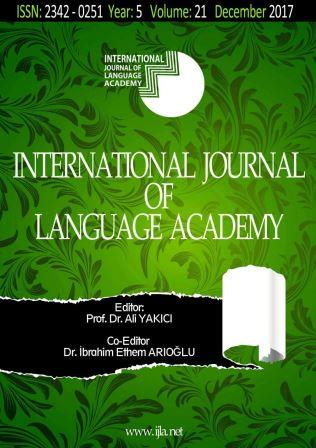Author :
Abstract
Kültürel belleğin kod aktarıcı sözlü ürünlerinden biri olan masal, söze dayalı yaratıcılığın, anlatarak yaşatmanın ve örnek olaylardan yola çıkarak öğretmenin gerçekleştirildiği bir türdür. Bu özelliği ile toplumsal belleğin hatırlatıcısı ve değer aktarıcısıdır. Yaratıldığı toplumun geleneği, sezgisi, yaşam felsefesinden izler taşıyan masal türünde, değer aktarımı ile kültürel süreklilik gerçekleştirilmektedir. Masal, bu toplumsal işlevinin yanı sıra bireyin yaşadığı çevreyi anlamlandırabilmesinin, iyiye, doğruya ulaşabilmesinin de yol göstericisidir. Masallarda ele alınan pek çok duygu ve düşünce; kişi, olay, nesne ve mekan bağlantısı içerisinde özellikle zıtlıklardan yola çıkılarak anlatılır. Bu bağlamda bir tarafta özellikle iyi ve kötü zıtlığına dayalı olarak idealleştirilen ve olması istenen örnek kişiler ve durumlar, diğer tarafta ise kaçınılan, istenmeyen olay ve kişiler yer alır. Özellikle zıtlığa dayalı olarak oluşturulan içerikte kötü ile ilişkilendirilen duygulardan biri de “korku” dur. Masallarda korku; nesne, insan ve mekan boyutuyla somutlaştırılır ve bu konuya genellikle günlük yaşamda karşılaşılan zorlukları ve tehlikeleri anlatma, yabancılaştırma ve ötekileştirme, hayatta kişilerin başına gelebilecek kötülüklere örnek verme ve uyarı amacıyla yer verilir. Korkunun içeriğini kültürel yapının değerler sistemi oluşturmakta böylelikle kötü ve korku bağlantısıyla genellikle kaçma ve uyarma davranışı oluşturulmaya çalışılır. Bu bağlamda korku kültürel yapının çok boyutlu sosyo-psikolojik anlamlar yüklü konusu halline gelir. Türk masallarında korkunun sadece psikolojik boyutu yoktur aynı zamanda felsefi ve sosyolojik anlam alt yapısı da bulunmaktadır. Korkunun dile getiriliş biçimleri bu bağlamda çok boyutlu bir anlam çözümlemesini gerektirmektedir. Bu bildiride Türk masallarında yer alan korku unsurları tespit edilecek, sınıflandırılacak, korkunun masallara yansıyan sembolik kodları ve söylemleri çözümlenecek ve bunların işlevi tartışılacaktır. Anahtar kelimeler: masal, korku, eğitim, kültür, kültürel bellek
Keywords
Abstract
A tale, one of the verbal translations of cultural memory, is a kind of story-based creativity, lived and narrated, and teachers are set out from the case studies. It is a reminder and value conveyor of social memory with this feature. Cultural continuity is realized through the transfer of value, in the kind of tale that carries traces of the tradition, intuition, life philosophy of the society that it creates. In addition to this social function, the tale is also a guide to the ability of the individual to understand the environment in which he lives, to achieve good, to the right. A lot of emotions and thoughts, person, event, object and space in the connection, especially out of the way is explained by way out. In this context, on the one hand, there are specimen persons and situations which are idealized and desired to be based on good and bad contrast, and on the other side are avoided, unwanted events and persons. One of the emotions associated with evil, especially in the content created on the basis of opposition, is fear. Fear in tales object, person, and space, and is often used to illustrate and challenge the difficulties and dangers encountered in everyday life, to alienate and alienate others, to exemplify the evils that may arise in life, and to warn others. The value system of cultural content constitutes the content of horror, thus trying to create a behavior of escaping and warning, usually in connection with bad and fear. In this context, the multifaceted socio-psychological meanings of the cultural structure of fear come to light. There is not only psychological dimension of horror in Turkish tales, but also philosophical and sociological meaning sub-structure. The form of expressing fear requires a multidimensional analysis of meaning in this context. In this declaration, the elements of the horror in the Turkish tale will be identified, the symbolic codes and discourses will be analyzed and their function will be discussed.





